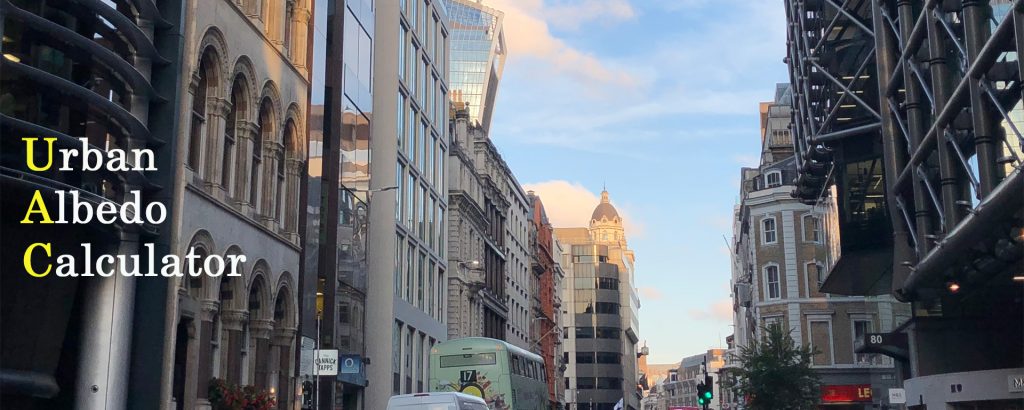Urban albedo -the capacity of urban surfaces to reflect solar radiation- is one of the most important contributors to changes in outdoor temperature, intensifying the urban heat island phenomenon, where temperatures in urban centres are higher than the surrounding rural environs.
The urban albedo is the proportion of the incoming solar radiation reflected by the various surfaces in the urban environment (reflection coefficient), defined as the ratio of incoming to outgoing radiation. As such, environments with an albedo of 0 absorb 100% of the incoming radiation and have no reflection, while those with an albedo of 1 reflect 100% of the incoming radiation back to the environment. The Greater London Authority (GLA) has identified urban albedo as one of the most significant parameters for mitigating the Urban Heat Island in London.
Considering the multiplicity and variability of the factors it is not advisable to predict the urban albedo of any location based on literature, especially in cities where surface changes are substantial. However, designers and urban development professionals need to know the urban albedo of the final urban setting in advance, to develop appropriate alternative urban development scenarios and to incorporate it in energy and thermal simulations of buildings. The project addresses this gap in knowledge by proposing to develop an urban albedo calculator (UAC) for application in high latitude locations, focusing on London as a case study.
Research Objectives
The primary objectives are:
- Provide underpinning data and tools to support incorporation of accurate calculation and prediction of urban albedo in planning and design processes for high latitude cities.
- Investigate experimentally the impact of urban fabric on urban albedo, using on London as a case-study.
- Develop a construction materials catalogue of urban albedo for various materials and geometrical configurations.
- Develop an urban albedo calculator, an empirical model to predict changes in urban albedo in relation to changes in urban fabric and solar altitude.
Programme and Methodology
- Task 1: Survey of urban typologies and albedo measurements.
- Task 2: Development of Experimental model and data acquisition.
- Task 3: Carrying out weathering test and assessment of optical properties.
- Task 4: Development of urban albedo calculator.
- Task 5: Urban modelling and simulation.
- Task 6: Dissemination and research papers.
Impact
The seasonal effect of urban albedo in reducing air temperatures can provide appropriate strategies in places like London, where albedo intervention will bring a substantial positive effect during the summer, to combat overheating, with marginal negative effects in winter when a warmer environment can be regarded as desirable. But to be able to provide reliable advice for such effects, the accurate calculation and prediction of the albedo of the urban mosaic is essential. The proposed Urban Albedo Calculator will bridge this gap and benefit the following user communities:
- Urban designers, architects and engineers will be able use the findings of this research in the form of the urban albedo calculator to manipulate urban geometry and urban fabric characteristics considering the local settings and microclimatic conditions to help achieve low energy developments.
- Building simulation users and modellers will benefit from both the experimental study and the urban albedo calculator as they will be in a better position to take into account the urban context.
- Local authorities and government organisations will benefit from the development of the urban albedo calculator because it could be used as a prediction model to inform urban planning decisions directed at avoiding the growth of the urban heat island/ heat risk.
- Paint and building material manufacturers will benefit from the field and experimental studies as it will help them to identify areas for future development of urban geometry specific reflective coatings/materials.
- Aim to link the UAC to freeware programs such as ENVIMET so that the data is freely available for built environment related professionals.
